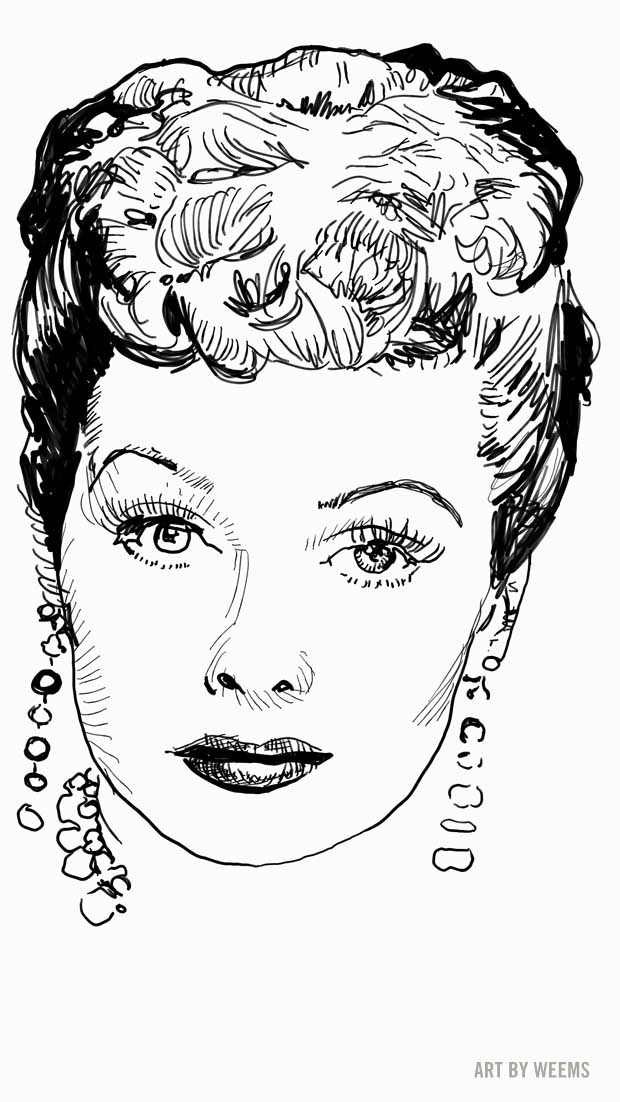Lucille Ball

Lucille Ball 1911-1989
If your familiarity with Lucille Ball is confined to her TV shows and specials from the 'golden age' of television until her death (1989), her film career in Hollywood comes as a bit of a shock. Instead of the ditzy comedienne and wife of Ricky Ricardo, Ball's motion picture work encompasses glamour-soaked roles under the cameras as a well as a variety of comedy efforts.
She started out in Hollywood as an extra in the 1933 Roman Scandals, and worked through a whole string of B-films (for example Five Came Back 1939) and some better budgeted-movies (The Big Street 1940, opposite Henry Fonda).
If you watch the Marx Brothers in Room Service (1938) and spot her while expecting comedy keeping with her I Love Lucy reputation, you'll be surprised how Ball is just another character foil for the Marx Brother's craziness.
However, a few years later when Ball appears in the Spencer Tracy and Katherine Hepburn Without Love (1945) it is clear Ball is combining both photogenic good looks of a veteran Hollywood female film actor with a handle on comedy well ahead of the average 'straight' actress, and the edge of I Love Lucy has started to show.
By the time she stars in the comedy The Fuller Brush Girl (1950) the "Lucy Ricardo" DNA is showing all the way through, but it is mitigated by the carefully photographed Hollywood star cinematography and her own 39 year old physical architecture.
In 1951 Lucille Ball started in her co-starring role opposite (then) husband Desi Arnez in the 181 episodes of I Love Lucy. This TV show had a popularity which eclipsed everything that had come before in her career, and introduced her to a wave of younger people who had little familiarity with her long career in Hollywood. It made a fortune for her and Arnez, and cemented her as the premier female comedy star of TV.
She appeared in 'serious' films on occasion afterward (for example the semi-comedic examination of adultery in The Facts of Life with Bob Hope, 1960) but her work thereafter was almost strictly comedy. By the time her final effort in front of the cameras was made (the 1986 Life with Lucy, 13 shows filmed, only 8 aired) she was carbonized into the I Love Lucy character by virtue of it's sheer success and global syndication.
She suffered from ornithophobia (a fear of birds) and banned all bird images from her home and offices. She attributed her comedic skills to her film favorite Carole Lombard, and to Buster Keaton.
Before Hollywood, Ball worked as a model under the name Dianne Belmont, contracted rheumatoid arthritis and spent two years re-learning how to walk. In her bit role as a slave in the 1933 Roman Scandals, she was required to shave off her eyebrows, and they never grew back.
Later, Ball was the first woman to ever own her own film studio as the head of Desilu Productions. Careful with investing and holding her money, she was often listed at different times as the wealthiest woman in American Television.
Original Page Dec 2013 | Updated April 2016
What's Recent
- Island of Desire - 1951
- Road to Morocco
- The Devil and Miss Jones - 1941
- Sinners - 2025
- Something for the Boys - 1944
- The Mark of Zorro - 1940
- The Woman They Almost Lynched - 1953
- The Cat Girl - 1957
- El Vampiro - 1957
- Adventures of Hajji Baba – 1954
- Shanghai Express 1932
- Pandora's Box – 1929
- Diary of A Chambermaid - 1946
- The City Without Jews - 1924
- The Long Haul
- Midnight, 1939
- Hercules Against the Moon Men, 1964
- Send Me No Flowers - 1964
- Raymie - 1964.
- The Hangman 1959
- Kiss Me, Deadly - 1955
- Dracula's Daughter - 1936
- Crossing Delancey - 1988
- The Scavengers – 1959
- Mr. Hobbs Takes A Vacation - 1962
- Jackpot – 2024
- Surf Party - 1964
- Cyclotrode X – 1966